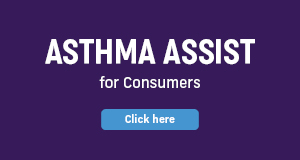Five easy steps to reduce your risk of asthma symptoms this winter
As the temperature cools down, the number of triggers for people with asthma can increase.
People with asthma can react to cold air and become susceptible to viruses and flu, which can bring on asthma symptoms.
We understand the management of your asthma can be challenging and sometimes complicated. We also know winter can be a difficult, tiring, and frustrating season for people with asthma. But having good asthma control means fewer asthma flare-ups, doctor visits, time off work, and hospitalisations.
So, as we head into winter, here are five actions you can take to help be asthma-ready for winter.
Take your preventer
Preventer medications taken following your written Asthma Action Plan are important to manage asthma symptoms.
If taken every day as directed by your doctor, they can help you to stay well.
Preventers act on the airways to reduce inflammation – redness, swelling, mucus, and sensitivity. They are usually low-dose corticosteroids that affect the narrowing of the airways, the underlying cause of asthma symptoms.
While they can be highly effective, they need time to work. For most people, this can take two to four weeks to reach full effect. For others, it can be up to three months.
Preventers are often prescribed for adults and young people whose asthma is not well controlled. This means they have had daytime symptoms twice or more in the last month, they have woken in the night with asthma symptoms once or more in the last month, have experienced an asthma flare-up in the last year, or used their reliever puffer more than twice in a week.
For children, doctors determine preventer use based on the severity and frequency of symptoms. This could be if their asthma is restricting their sleep or activities, if they are having moderate-severe flareups, they have an asthma episode that leads to being hospitalised, flare ups every 6 weeks or more often, daytime symptoms more than once per week, or night-time symptoms more than twice per month.
Preventers are safe and effective medications when taken as prescribed. [1]
Have an asthma review
Make sure you are asthma-ready with a review.
We recommend seeing your doctor every six months to a year, depending on your level of asthma control.
If you are pregnant, the Australian Asthma Handbook suggests you should have your asthma reviewed by your doctor every four weeks.
An asthma review should also be organised for within three days with your doctor if you have been to the emergency department or been hospitalised for your asthma and again 2-4 weeks later.
During your asthma review ask your doctor to check your asthma control, lung function, review any risk factors, discuss your preventer and reliever medications, check your asthma device technique, and talk about your triggers.
You and your doctor can also review your written Asthma Action Plan together.
Update your Asthma Action Plan
Your written Asthma Action Plan is your guide to daily living with asthma.
It sets out clearly what you need to do when you are feeling well, what to do when you start to experience symptoms and if they worsen, and what to do as those symptoms ease.
A written Asthma Action Plan also includes emergency information that is critical for schools and other care facilities.
It is an important document – easy to prepare with your doctor – but many adults with asthma don’t have one.
The Australian Institute of Health and Welfare found only about one in four people with asthma over 15 years had an Asthma Action Plan.
Ahead of this winter, go and get one.
Get AirSmart this winter
When you are air smart, you know the quality of the air you are breathing in.
Try the air quality monitoring app AirRater, or make your state’s air quality index is one of your favourite sites. Check the information regularly.
Consider whether you would benefit from an air purifier. There are many on the market, so do your own research to find out what is best for your situation.
If poor air quality is an issue where you live or work, try and make your environment the best it can be. Use the air-conditioner on reverse cycle and make the space as airtight as possible.
“Clean-air shelters” can also help to provide a haven for short periods of time.
Stay up to date with vaccinations
Vaccinations are a proven way to prevent the spread of some diseases.
The annual flu vaccination is the best way to reduce your risk of getting influenza.[2]
You should have the flu vaccination each year because the influenza virus is always changing.
While flu circulates in the community all year, it has traditionally reached a peak from June to September, so many vaccination programs start from mid-April.[3]
This year many people will be getting their COVID-19 vaccination, as a protection against the virus causing the global pandemic.
If you are planning to get both vaccinations, Australian officials recommend waiting 14 days between the flu vaccination and the COVID-19 vaccination.
Stay up to date with the latest in asthma health and prevention tips. Check back here on the website regularly as we have new content frequently.
Get support with your asthma, join Asthma Assist today!
References
- https://www.health.qld.gov.au/clinical-practice/guidelines-procedures/diseases-infection/immunisation/service-providers/influenza
- https://www.health.gov.au/resources/publications/covid-19-vaccination-atagi-advice-on-influenza-and-covid-19-vaccines
- https://www.asthmahandbook.org.au/management/children
- https://asthma.org.au/about-asthma/medicines-and-devices/preventers/
PARTNERS
ENT, echamber, AirPhysio and Sanofi are campaign partners of Asthma Australia and have not been involved in the development of this webpage.











